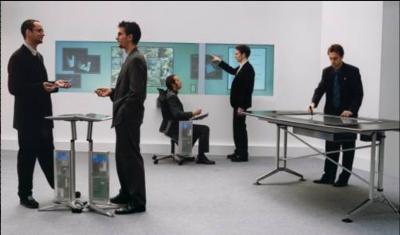Roomware®
Fig. 1: Second Generation of Roomware components (as of 1999)
Roomware® was defined and realized by Streitz and his Ambiente-Team at IPSI and described in various publications (Streitz et al., 1998, 1999, 2001, 2002, Prante et al. 2004) as the integration of
information and communication technology in room elements, such as doors, walls, and furniture. They are part of their approach that the ‘world around us’ is the interface to information and for the
cooperation of people. Thus, the Roomware approach moves beyond the limits of standard desktop environments on several dimensions and extends usage into the architectural environment as well as
outside of buildings into public spaces, etc. They are the constituents of Cooperative Buildings that represent the more comprehensive scenario.
The Roomware components address also the potential of different interaction opportunities with (smart) artefacts. Examples for interacting with large vertical displays as, e.g., interactive
walls are provided by the DynaWall; interacting with horizontal displays as, e.g., via the InteracTable or the ConnecTables. Examples of interaction and collaboration of several people using multiple
artefacts are provided, e.g., by the combination of CommChairs with the DynaWall. The setting is complemented by the Passage mechanism (Konomi et al., 1999) which provides an intuitive way for the
physical transportation of virtual information structures using arbitrary physical objects, so called ‘Passengers’. An overview of the different Roomware components is shown in the picture above. The
roomware components were developed in close cooperation with industry (Wilkhahn) in the Future Office Dynamics Consortium (FOD) and won several design prizes and research awards. Some of
them, e.g., the InteracTable, are available as commercial products via a spin-off created by Wilkhahn.
For an overview of the 2. generation of roomware components see the video at the CHI 2002 conference, available for free at the ACM Digital Library.
References
N. Streitz, J. Geißler, T. Holmer (1998). Roomware for Cooperative Buildings: Integrated Design of Architectural Spaces and Information Spaces. In: Streitz, N., Konomi, S., Burkhardt, H. (Eds.),
Cooperative Buildings - Integrating Information, Organization, and Architecture. (Proceedings of CoBuild '98, Darmstadt, Germany), LNCS Vol. 1370, Springer, 1998. pp. 4-21.
N. Streitz, J. Geißler, T. Holmer, S. Konomi, C. Müller-Tomfelde, W. Reischl,
P. Rexroth, P. Seitz, R. Steinmetz (1999). i-LAND: An interactive Landscape for Creativity and Innovation. In: Proceedings of ACM CHI'99 Conference
(Pittsburgh, USA, May 15-20, 1999). pp. 120-127.
N. Streitz, C. Müller-Tomfelde, P. Seitz (1999). Kooperative Gebäude und Roomware für die Arbeitswelten der Zukunft. In: N. Streitz, B. Remmers, M. Pietzcker, R.
Grundmann (Eds.), Arbeitswelten der Zukunft - fit für die Zukunft? Deutsche Verlags-Anstalt (DVA), Stuttgart. pp. 21-35.
N. Streitz, P. Tandler, C. Müller-Tomfelde, S. Konomi (2001). Roomware: Towards the Next Generation of Human-Computer Interaction based on an Integrated Design of Real and Virtual Worlds. In: J.
Carroll (Ed.), Human-Computer Interaction in the New Millenium, Addison-Wesley, 2001. pp. 553-578.
P. Tandler, N. Streitz, Th. Prante (2002). Roomware: Moving Toward Ubiquitous Computers. IEEE Micro, November/December, 2002. pp. 36-47.
S. Konomi, C. Müller-Tomfelde, N. Streitz (1999). Passage: Physical Transportation of Digital Information in Cooperative Buildings.
In: Streitz, N., Siegel, J., Hartkopf, V., Konomi, S. (Eds.), Cooperative Buildings - Integrating Information, Organizations, and Architecture. (Proceedings of CoBuild'99, Pittsburgh, USA).
LNCS Vol. 1670, Springer, 1999. pp. 45-54.
Th. Prante, N. Streitz, P. Tandler (2004). Roomware: Computers Disappear and Interaction Evolves. IEEE Computer, December 2004. pp. 47-54.



